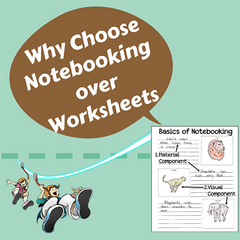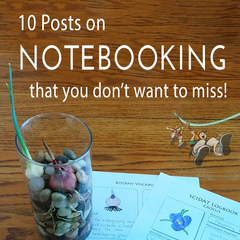Hey, folks! I’m so happy to be back on the Sassafras Science blog sharing once again about notebooking!
Blaine and Tracey asked me to send a virtual wave to you all. They said to also let you know that they will be back next time to share something special from one of the local experts on their botany leg!
Ok, so back to the topic - notebooking with different ages. Notebooking is amazingly flexible, which means that it can grow with your students.
Today, I wanted to take a moment to give you a few ideas about what notebooking can look like at the different stages.
Notebooking With Different Ages
Preschool Notebooking
Most preschool students are not writing complete sentences. These years are really pre-writing ones. So, notebooking during this time will be very simple.
Preschoolers can easily notebook about:
- Letters, colors, and shapes;
- Books that have been read to them;
- Simple science activities they have done;
- Simple social study/history topics.
In each case, they can draw or cut out pictures to depict the topic. You may also want to have them dictate a few words or sentences to you, but it is not absolutely necessary.
In essence, the preschool notebooking page will be highly visual.
Elementary Notebooking
Elementary students are learning how to read and write. Their notebooking pages will serve as a record of their growing skills.
The elementary notebooking page will include the visual and material components, but how much writing will depend upon the students’ abilities. So:
- The first-grade notebooking page may only have a sentence or two that they have dictated to you;
- The second-grade notebooking page may have three or four sentences that they have dictated to you;
- The third-grade notebooking page may have one or two sentences they have written on their own;
- The fourth-grade notebooking page may have three or four sentences they have written on their own.
In short, there will be a lot of variety in the look of notebooking pages throughout the elementary years.
Middle School Notebooking
Middle school students are learning how to organize and process information. Notebooking at this stage will be more structured than it has been in previous years.
You can do this through the use of:
- Labeled sketches or diagrams;
- Maps and timelines;
- Outlines (either single or multi-level);
- Complex narrations (i.e. one or more coherent paragraphs).
So, the middle school notebooking page will be used to show what the students have learned, and it will be used to help them process and organize that information.
When you boil it down, the middle schoolers' notebooking pages will show a high level of organization.
High School Notebooking
Like in middle school, high schoolers will use more detailed images and complex writing tools on their notebooking pages. The difference is that their notebooking pages will also include their thoughts on the subject.
Here are a few ideas in addition to the items listed above of what their pages could consist of:
- Literary critiques of a book they read;
- Ideas on the cause and effect a certain historical event;
- How a certain passage affected them;
- Reasons for why a certain experiment turned out the way it did.
Notebooking is definitely a tool you can still use with your high school student as it can easily reflect their growing maturity.
A Final Word
Throughout the years, notebooking is a beneficial way to document what your students have learned in a way that is meaningful to them.
Preschoolers can use notebooking to visually depict the building blocks they are learning. Elementary students can use notebooking to practice their budding skills. Middle schoolers can use notebooking to begin to organize their thoughts. And high schoolers can use notebooking to communicate their opinions.
I trust that you will glean several ideas from this post on how you can use notebooking with different ages!


